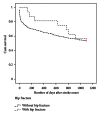Hip fractures in persons with stroke
- PMID: 23691433
- PMCID: PMC3649805
- DOI: 10.1155/2013/954279
Hip fractures in persons with stroke
Abstract
Background. Our aim was to determine the incidence of hip fractures within two years after stroke, to identify associated factors, to evaluate which test instruments that best could identify people at risk, and to describe the circumstances that prevailed when they sustained their hip fractures. Method. A total of 377 persons with first-ever stroke were followed up for a 24-month period. Stroke severity, cognition, and associated medical conditions were registered. The following test instruments were used: National Institutes of Health Stroke Scale, Mini-Mental State Examination, Berg Balance Scale, Timed Up & Go, and Stops Walking When Talking. Result. Sixteen of the persons fractured their hip within the study period, which corresponds to an incidence of 32 hip fractures per 1000 person-years. Persons with fractures more often had impaired vision and cognitive impairment and more had had previous fractures. Of the investigated test instruments, Timed Up & Go was the best test to predict fractures. Conclusion. The incidence of hip fractures in persons with stroke was high in this study. Persons with previous fractures, and visual and cognitive defects are at the greatest risk. Certain test instruments could be used in order to find people at risk, which should be targeted for fall preventive measures.
Figures
References
-
- Batchelor F, Hill K, MacKintosh S, Said C. What works in falls prevention after stroke? A systematic review and meta-analysis. Stroke. 2010;41(8):1715–1722. - PubMed
-
- Cummings SR, Melton LJ. Osteoporosis I: epidemiology and outcomes of osteoporotic fractures. The Lancet. 2002;359(9319):1761–1767. - PubMed
-
- Kanis J, Oden A, Johnell O. Acute and long-term increase in fracture risk after hospitalization for stroke. Stroke. 2001;32(3):702–706. - PubMed
-
- Pouwels S, Lalmohamed A, Leufkens B, et al. Risk of hip/femur fracture after stroke: a population-based case-control study. Stroke. 2009;40(10):3281–3285. - PubMed
-
- Ramnemark A, Nyberg L, Borssén B, Olsson T, Gustafson Y. Fractures after stroke. Osteoporosis International. 1998;8(1):92–95. - PubMed
LinkOut - more resources
Full Text Sources
Other Literature Sources


